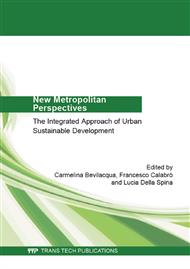[1]
G. Becattini: The Marshallian industrial district as socio-economic notion, in: F. Pyke, G. Becattini, W. Sengenberger (Eds. ), Industrial districts and inter-firm co-operation in Italy, International Institute for Labour Studies (ILO), Geneva (1990).
DOI: 10.1177/002218569103300114
Google Scholar
[2]
S. Brusco: The idea of the industrial district: its genesis, in: F. Pyke, G. Becattini, W. Sengenberger (Eds. ), Industrial districts and inter-firm co-operation in Italy, International Institute for Labour Studies (ILO), Geneva (1990), pp.10-19.
DOI: 10.1177/002218569103300114
Google Scholar
[3]
M. E. Porter: The Competitive advantage of nations, MacMillan, London (1990).
Google Scholar
[4]
R. Camagni: Innovation networks: spatial perspectives, Belhaven, London (1991).
Google Scholar
[5]
P. Cooke: Regional innovation systems, clusters, and the knowledge economy, Industrial and Corporate Change 10: 4 (2001), pp.945-974.
DOI: 10.1093/icc/10.4.945
Google Scholar
[6]
B. Asheim: Industrial districts as learning regions,: a conditions for prosperity, European Planning Studies 4: 4 (1996), pp.379-400.
DOI: 10.1080/09654319608720354
Google Scholar
[7]
D. B. Audretsch: Agglomeration and the location of innovative activity, Oxford Review of Economic Policy 14 (1998), pp.18-29.
DOI: 10.1093/oxrep/14.2.18
Google Scholar
[8]
Z. J. Acs: Innovation and the growth of cities, Edward Elgar, London (2002).
Google Scholar
[9]
Innovating Regions in Europe (IRE), Mutual learning platform, Synthesis Report, Luxembourg (2006).
Google Scholar
[10]
European Commission (EC), Good practice in the field of regional policy and obstacles to the use of the structural funds, Brussels, Commission of the European Communities. Directorate-General for Regional Policy, Policy Department Structural and Cohesion Policies (2008).
Google Scholar
[11]
J. B. Barney, W. Hesterly: Organizational economics: understanding the relationship between organizations and economic analysis, in: S. Clegg and C. Hardy (Eds. ), Studying Organization: Theory and Method, Sage Publications, London, 1999, pp.111-48.
DOI: 10.4135/9781446218556.n4
Google Scholar
[12]
C. Oughton, M. Landabaso, K. Morgan: The regional innovation paradox: innovation policy and industrial policy, Journal of Technology Transfer 27 (2002), pp.97-110.
Google Scholar
[13]
D. Foray, Globalization of R&D: linking better the European economy to foreign, sources of knowledge and making EU a more attractive place for R&D investment, Brussels: European Commission (2006).
Google Scholar
[14]
L. Soete, The role of community research policy in the knowledge-based economy. Expert Group Report, Brussels: European Commission, Directorate-General for Research (2009).
Google Scholar
[15]
A. L. Olivier, J. P. Liebeskind: Three levels of networking for sourcing intellectual capital in biotechnology: implications for studying inter-organizational networks, International Studies of Management & Organization, 27 (1998), pp.76-104.
DOI: 10.1080/00208825.1997.11656719
Google Scholar
[16]
P. Cooke: Regionally asymmetric knowledge capabilities and open innovation. Exploring Globalization 2, – A new model of industry organization, Research Policy, 34 (2005) 1128-1149.
DOI: 10.1016/j.respol.2004.12.005
Google Scholar
[17]
D. J. Teece, G. Pisano, A. Schuen: Dynamic Capabilities and Strategic Management, Strategic Management Journal, 18: 7 (1997), pp.509-533.
DOI: 10.1002/(sici)1097-0266(199708)18:7<509::aid-smj882>3.0.co;2-z
Google Scholar
[18]
D.J. Teece: Explicating dynamic capabilities: the nature and microfoundations of (sustainable) enterprise performance. Strategic Management Journal, 28: 13 (2007), pp.1319-1350.
DOI: 10.1002/smj.640
Google Scholar
[19]
A.B. Jaffe, M. Trajtenberg, R. Henderson: Geographic localization of knowledge spillovers as evidenced by patent citations, Quarterly Journal of Economics, 108: 3 (1993), pp.577-598.
DOI: 10.2307/2118401
Google Scholar
[20]
P. Almeida, B. Kogut: Localization of knowledge and the mobility of engineers in regional networks, Management Science, 45: 7 (1999), pp.905-917.
DOI: 10.1287/mnsc.45.7.905
Google Scholar
[21]
R. Boschma: Proximity and innovation: a critical assessment, Regional Studies, 39: 1 (2005), pp.61-74.
DOI: 10.1080/0034340052000320887
Google Scholar
[22]
A. Agrawal, I. Cockburn, J. McHale: Gone but not forgotten: knowledge flows, labour mobility, and enduring social relationships, Journal of Economic Geography, 6: 5 (2006), pp.571-591.
DOI: 10.1093/jeg/lbl016
Google Scholar
[23]
M. O. Jackson, Y. Zenou (Eds): Economic analyses of social networks, Elgar Research Collection, Cheltenham, UK, Northampton, MA, USA (2013).
Google Scholar
[24]
M. P. Vittoria, G. Lubrano Lavadera: Knowledge networks as the nouvel milieu of biotechnology firms in peripheral regions. Paper presented at 35th DRUID Celebration Conference 2013, Barcelona, Spain, June 17-19.
Google Scholar
[25]
J. Scott, P. J. Carrington (Eds. ): The SAGE handbook of social network analysis. SAGE, London (2011).
Google Scholar
[26]
P. V. Marsden: Recent development in network measurement, in: P.J. Carrington, J. Scott, S. Wasserman (Eds. ), Models and Methods in Social Network Analysis, Cambridge University Press, New York, (2005), pp.8-30.
Google Scholar
[27]
E. Glaeser, H. Kallall, J. Scheinkman, A. Shleifer: Growth in cities, Journal of Political Economy, 100 (1992) pp.1126-1152.
DOI: 10.1086/261856
Google Scholar
[28]
M. Feldman, D. Audretsch: Innovation in cities: science-based diversity, specialization and localized competition, European Economic Review, 43 (1999), pp.409-429.
DOI: 10.1016/s0014-2921(98)00047-6
Google Scholar
[29]
P. Persico: La città e l'altra città. Racconti ed esperienze in-disciplinate nella pianificazione anti-fragile. Palazzo Bonaretti editore srl, Novellara (RE) (2013).
Google Scholar
[30]
S. Kuhlmann: Future governance of innovation policy in Europe – three scenarios, Research Policy, 30 (2001), pp.953-976.
DOI: 10.1016/s0048-7333(00)00167-0
Google Scholar
[31]
A. Lagendijk: Regional innovation policy between theory and practice, in: P. Cooke with Bjørn Asheim, R. Boschma, R. Martin, D. Swartz, and F. Tödtling (Eds. ), Handbook of Regional Innovation and Growth, EE, Cheltenham, UK, Northampton, MA, USA, (2011).
DOI: 10.4337/9780857931504.00009
Google Scholar


